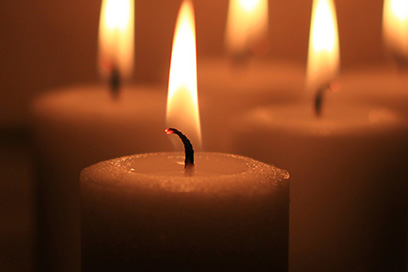4 mins read
Future of Sackrider Hill cross in debate
by Tina Cole-Mullins

On a hill not so far away, stands an old rugged cross — in the Waterloo State Recreation Area near Grass Lake, Mich. For nearly 70 years at the top of Sackrider Hill, the white cross has stood stately upon state land, overlooking those who pass below on Interstate 94, barely visible even to a knowing eye.
Now some have filed complaints that the long-standing cross is a violation of separation of church and state, according to an unnamed lifelong resident and the Michigan Association of Civil Rights Activists (MACRA).
Mitch Kahle, co-founder of MACRA, in a March 10 letter to the Michigan Department of Natural Resources, claimed it is unconstitutional to have a religious symbol in the Waterloo State Recreation Area. The state DNR is reviewing the claim and will be in touch with Kahle upon completion of the review.
“MACRA has demanded the DNR remove the cross from Sackrider Hill, located in the state’s Waterloo Recreation Area, on grounds that the cross violates both the Establishment Clause of the First Amendment and Article I, Section 4 of the Constitution of the state of Michigan,” Kahle said.
Kahle said the U.S. Supreme Court denied an appeal April 2 in a similar case, in which a previous ruling deemed a pole could not be turned into a cross on public land in Grand Haven, Mich.
Long history
Sackrider Hill is named for the Sackrider family, who settled in the area in the mid-1840s. About a century later, it became a traditional gathering place of celebration for the sunrise Easter service of surrounding United Methodist communities. The location was selected because it was the perfect midway point to preach to the congregations.
The Easter service of 1938 brought a special guest speaker, the Rev. George Bennard, author of the hymn “The Old Rugged Cross.”
In these early years, a cross was carried up the hill on Good Friday and removed after the Sunday service. But by 1950, a permanent cross was erected, according to a recent report in the Jackson Citizen Patriot.
Some see the cross as a memorial to Carailyn Waldron, a 16-year-old senior at Jackson High School. According to the Jackson Citizen Patriot report, she was killed in September 1958 on Labor Day weekend at Sackrider Hill by her ex-boyfriend, John Hixon. Many since have connected the cross with the gruesome murder, bringing with it the name “Murder Mountain.”
This year, the Easter sunrise service went on as always, and according to those in attendance, 90 to 100 worshippers made the pre-dawn trek up the snow-covered trail.
More than a symbol
What does the cross mean to the community?
For many near and far, the cross is more than a religious symbol. It holds childhood memories of sledding place or a lovers lane for others. The carved-out ruts

that scar the terrain are a reminder of all the dirt bikers who climbed to the top. It’s still a popular scenic hiking and picnicking spot, as the cross and observance deck are on the second-highest point in Jackson County.
Saving the cross
In response to the MACRA letter and demand, Grassroots Jackson, a volunteer-based organization, launched a campaign and started a petition to “Save the Jackson Cross.”
“Our goal is to give a voice to the thousands of people who support the cross, in stark comparison to the one unnamed individual who wants it removed,” said Billie Dawson of Grassroots Jackson.
Group organizers say they have collected more than 3,000 signatures and “they are amazed by the (number of) signatures that are continuing to come in.”
“The display of the cross has already been challenged and resolved in April 1992,” Dawson said. “A permanent-use permit was granted to the Grass Lake Ministerial Association by the DNR for the placement and maintenance of the cross on Sackrider Hill for as long as the association was in existence.”
Grassroots Jackson plans to send results of the “Save The Cross” petition, along with letters, to the DNR and other state officials and leaders.
“We are not encouraging individual letters at this time. We are a group of volunteers who share information aligned with our mission to educate, encourage, and engage Jackson County,” Dawson said.
The “Save The Cross” petition can be found at www.savejacksoncross.com.
7 thoughts on “Future of Sackrider Hill cross in debate”
Comments are closed.




They will take it down because that is the kind of intolerance that surrounds us now.
Intolerance of Christian privilege. It’s very important to keep this nation secular.
You should check out “Father Marquette Cross” in Ludington Michigan. They are doing the same thing (MACRA) in our community. Better prepare for battle.
The way I see it (…and the law sees it), Public lands such as this are for ALL taxpayers to enjoy. Religious organizations are NOT taxpayers and pay absolutely nothing…..so, why do they (in this case Christians) feel entitled to place their religious symbols on public property? They have their own lands to place such things. I see it as pressing their beliefs…and as for the fact it has been there since the 1950’s, conservatives will argue that even though it violates the law (then and now)…they will make the same argument if someone has lived illegally in the USA that time is not a determining factor and must be deported at once….I claim in response time is not a determining factor and the cross should be removed at once (it can be moved to church property)
Its a sad day for me to know the cross is gone my dad Johnnie B Cole took me there for are one on one time . We had long talks about how life is good to us . I’m sad
Some remnants of what our ancestors believed should remain. Some reminder of a better day and a better way.
Love the “better day and a better way” Still can’t understand why a small handful rules over a HUGE majority. Thought this country was ruled by the majority and votes for any election were counted that way. But no matter, if it were a tree growing in that spot and one person didn’t like it, it would be gone.This is happening more and more lately with other numerous values.